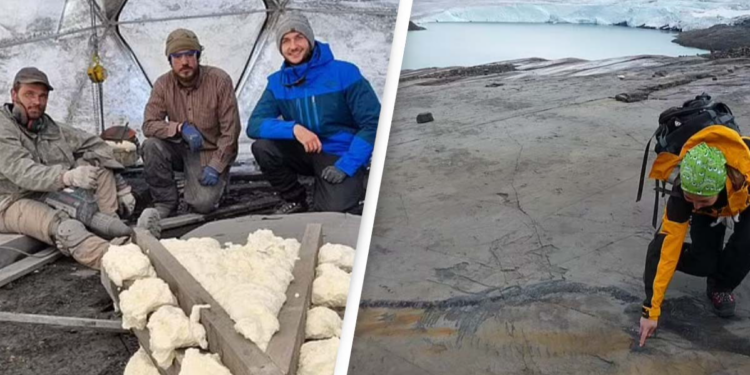The fossilized bones of a 13-foot-long pregnant ichthyosaur have been discovered in Chile, making it the country’s first complete ichthyosaur discovery.
Fiona’s remains were discovered in a melting glacier deep in Patagonia by researchers from the University of Manchester.
Fiona was pregnant when she died 139 million years ago, with numerous embryos remaining in her womb.

‘The significant quantity of ichthyosaurs recovered in the area, including entire skeletons of adults, juveniles, and neonates, gives a unique insight into the past,’ says the study.
Ichthyosaurs were dinosaur-era sea reptiles known for their fish-like morphology, similar to today’s dolphins.
Fiona’s bones were discovered during a March and April 2022 trip to the Tyndall Glacier.
The glacier is a 10-hour trek or horseback ride distant, making collection very challenging.
The voyage lasted 31 days and was regarded as a “nearly titanic task” by the researchers.
The ichthyosaur is the sole documented and removed pregnant female of Valanginian-Hauterivian age (between 129 and 139 million years old from the Early Cretaceous).

Along with Fiona, the crew uncovered 23 more specimens during the expedition, making the Tyndall Glacier the world’s most prolific ichthyosaur cemetery.
‘The expedition’s results exceeded all expectations,’ said the expedition’s leader. Dr. Pardo-Perez continued.
‘We expect to acquire outcomes just on diversification, discrepancy, as well as palaeobiology of the marine reptiles of the Tyndall Glacier locality, create diplomas of bone sophistication, and environmental niches to assess potential nutritional transition process that took place all through their evolution, and that could help to establish palaeobiogeographical connections with ichthyosaurs from other latitudes.’

They also need specialized tools to break through the hard rock.
‘The rock of the outcrop is so hard that we couldn’t extract it with a lump hammer, chisel, and brush, so we had to cut, drill, and shatter blocks using diamond and high caliber equipment,’ said one of the excavators, Hector Ortiz.
‘We were only two individuals who built glacier camp, and we managed to get the complete ichthyosaur from the southern tip of America to the globe in two helicopter flights in a month of fieldwork.’
They had to carry Fiona’s bones from high in the Tyndall Glacier to the Rio Seco Museum of Natural History in Punta Arenas, around 250 miles distant.
The ichthyosaur will now be processed at the museum’s paleontology laboratory and temporarily kept for future exhibition.
The site’s additional ichthyosaurs will not be excavated.

‘The ichthyosaurs that will not be dug require preservation and consolidation in situ, as the erosion they face daily is killing them.’
The researchers intend to compare the ichthyosaurs discovered in the Tyndall Glacier to those previously found in Europe.
Dr. Erin Maxwell, curator at the State Museum of Natural History in Stuttgart and a specialist on ichthyosaurs, added: ‘We don’t have many marine reptile fossils from this period (130-140 million years ago) worldwide, and the ones we do have are from Europe.
‘The Tyndall location is highly significant in filling a gap in our understanding of the sorts and overall variety of animals that inhabited the southern hemisphere’s ocean, particularly in moderate to polar latitudes.’























